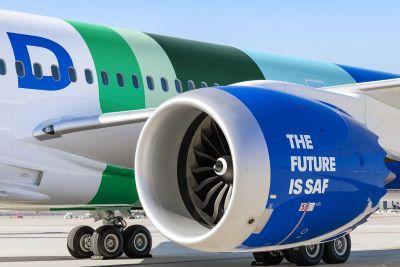Thu, Jun 05, 2025
Sustainability Push is Still Ongoing, But There’s a Long Way to Go
The International Air Transport Association updated their fact sheet on Sustainable Aviation Fuel, providing a hint at what the rest of 2025 should look like for the eco-friendly Jet-A replacement.

Everything appears to be on track for a Net Zero Carbon goal in 2050, even if the hard numbers today don’t quite seem high enough. We've still got 25 years to go, after all. The biggest impediments remain the same, high costs and limited distribution keep SAF use low for the time being. But that's how any new technology goes, and sustainable fuels are getting more support from manufacturers, operators, and regulators than most other newfangled tech. Overall, the IATA expects SAF production to reach only 2Mt this year, working out to about 0.7% of jet fuel use worldwide. On the bright side, they say, SAF mandates in the United Kingdom and European Union kicked in to help provide the kind of scaffolding the industry needs to succeed.
In addition, the IATA launched the SAF Registry, a system to record transactions in a “standardized and transparent way.” The Registry ensures that the environmental benefits of SAF are tracked throughout the value chain, allowing users some peace of mind that their purchases really do provide the ecological benefits promised on the box. As the push for SAF is increasingly felt at the ground level, the Registry will become invaluable, if only to prevent the spread of grifts and schemes. How could a buyer truly know they just filled up with Sustainable Fuel? How could they know it's compliant? How could they know its sources further upstream in the supply chain? IATA's registry helps to answer those questions with a framework that works with everyone, particularly across international bodies in similar work.

The Registry ensures carriers have access to SAF with clear, codified origins and genuinely 'sustainable' sources, while helping them tackle their eco-accounting without double counting projects or tossing money into the black hole of graft. (And when SAF is running about 150% of Jet-A costs, it's not impossible someone would try some creative re-labeling.)
IATA followed up with a quick roundup of 4 key conclusions regarding the industry at large: “The air transport industry’s energy transition is feasible on the 2050 horizon”, “The amounts of investments needed to make that possible are comparable to those engaged in previous creations of new renewable energy markets,” “Success in the transition depends critically upon policymakers’ unity of purpose,” and “The time left for joining forces in air transportation’s energy transition is shrinking by the minute. Every action delayed is an opportunity missed.”
More News
Aero Linx: Transport Canada We are a federal institution, leading the Transport Canada portfolio and working with our partners. Transport Canada is responsible for transportation p>[...]
Gross Navigation Error (GNE) A lateral deviation from a cleared track, normally in excess of 25 Nautical Miles (NM). More stringent standards (for example, 10NM in some parts of th>[...]
From AirVenture 2017 (YouTube Edition): Flight-Proven Booster On Display At AirVenture… EAA AirVenture Oshkosh is known primarily as a celebration of experimental and amateu>[...]
Aircraft Parachute System (CAPS) Was Deployed About 293 Ft Above Ground Level, Which Was Too Low To Allow For Full Deployment Of The Parachute System Analysis: The day before the a>[...]
Also: 48th Annual Air Race Classic, Hot Air Balloon Fire, FAA v Banning 100LL, Complete Remote Pilot The news Piper PA-18 Super Cub owners have been waiting for has finally arrived>[...]
 ANN's Daily Aero-Linx (06.29.25)
ANN's Daily Aero-Linx (06.29.25) ANN's Daily Aero-Term (06.29.25): Gross Navigation Error (GNE)
ANN's Daily Aero-Term (06.29.25): Gross Navigation Error (GNE) Classic Aero-TV: Anticipating Futurespace - Blue Origin Visits Airventure 2017
Classic Aero-TV: Anticipating Futurespace - Blue Origin Visits Airventure 2017 NTSB Final Report: Cirrus SR22
NTSB Final Report: Cirrus SR22 Airborne Affordable Flyers 06.26.25: PA18 Upgrades, Delta Force, Rhinebeck
Airborne Affordable Flyers 06.26.25: PA18 Upgrades, Delta Force, Rhinebeck




